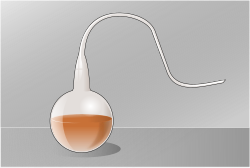Louis Pasteur
Louis Pasteur (December 27, 1822 – September 28, 1895) was a French microbiologist and chemist.[1] He and his wife, Marie, are best known for their experiments supporting the germ theory of disease, and he is also known for his vaccinations, most notably the first vaccine against rabies and anthrax.
Louis Pasteur | |
|---|---|
 Louis Pasteur by Albert Edelfelt, 1885 | |
| Born | 27 December 1822 |
| Died | 28 September 1895 (aged 72) |
| Known for | First vaccine against rabies |
Career
He made many discoveries in the field of chemistry, including the asymmetry (different shapes) of crystals. He is also well known for his way of keeping milk and wine from going sour for longer periods of time. That process is called pasteurization. It is when the milk and or wine is put under about 161 Fahrenheit (72 Celsius) for fifteen seconds. [2]
Pasteur's later work on diseases included work on chicken cholera. During this work, Pasteur noticed how a culture of the responsible bacteria had spoiled, and it failed to induce the disease in some chickens, which he was infecting, with the disease.
Personal life
Louis Pasteur was born on December 27, 1822 in Dole in the Jura region of France, into the family of a poor tanner. Louis grew up in the town of Arbois.[3] He gained degrees in Letters and in Mathematical Sciences before entering the École Normale Supérieure, an elite college, as well as the Conservatoire national des arts et métiers.
After serving briefly as professor of physics at Dijon Lycée in 1848, he became professor of chemistry at the University of Strasbourg,[3] where he met and courted Marie Laurent, daughter of the university's rector, in 1849.
Louis Pasteur and Marie were married on May 29, 1849, and together had five children. Only two survived to adulthood; his other three children had died of typhoid fever. These personal tragedies inspired Pasteur to try to find cures for diseases, such as typhoid.
Death
In 1895 at Marnes-la-Coquette, a commune in Paris, Pasteur died after several strokes.
Louis Pasteur Media
The house in which Pasteur was born, Dole
Pasteur separated the left and right crystal shapes from each other to form two piles of crystals: in solution one form rotated light to the left, the other to the right, while an equal mixture of the two forms canceled each other's effect, and does not rotate the polarized light.
Bottle en col de cygne (swan-neck bottle) used by Pasteur
Captioned "Hydrophobia", caricature of Pasteur in the London magazine Vanity Fair, January 1887
References
- ↑ "Pasteur, Louis – Biographical entry – Encyclopedia of Australian Science". eoas.info. Retrieved 23 March 2010.
- ↑ Foodsafetysite. Archived 2018-10-07 at the Wayback Machine from https://web.archive.org/web/20181007010412/http://www.foodsafetysite.com/educators/competencies/general/foodprocessing/processing2.html
- ↑ 3.0 3.1
 James J. Walsh (1913). "Louis Pasteur". Catholic Encyclopedia. New York: Robert Appleton Company.
James J. Walsh (1913). "Louis Pasteur". Catholic Encyclopedia. New York: Robert Appleton Company.
Related pages
| Wikimedia Commons has media related to Lua error in Module:Commons_link at line 62: attempt to index field 'wikibase' (a nil value).. |








